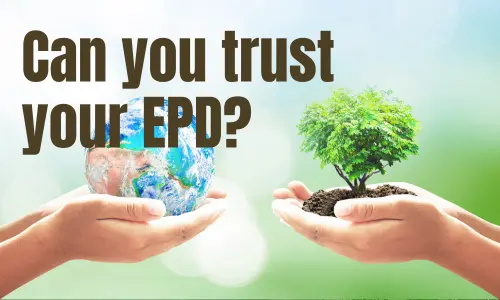News and Updates
Can you trust your EPD?
17-Oct-2025
Environmental product declarations are an important tool for measuring materials’ environmental impact, and the construction industry is moving towards mandating that all products EPDs. Without them, projects can suffer in environmental assessments. For more information on what EPDs are and cover, see our article on ‘How to pick an EPD’.
Is an EPD representative of the product?
EPDs should offer a standardised and comparable way to measure environmental performance. But unfortunately, they are still often used incorrectly.
Some steel producers use EPDs that, while technically still in date, no longer align with the actual steel being produced. EPDs can be valid for up to five years, but production methods, energy sources, and supply chains can change significantly during that time, altering the environmental profile.
An example of such practices would be a rolling mill that changes the source of its billet material for economic reasons. An EPD is produced on the practices of the mill at the time of assessment. Changes to the production require a reassessment of EPD, however, there is a lag in data collection for EPD revisions. Furthermore, some players also continue to improperly put forward superseded EPD to the unwary to try and substantiate sustainability credentials.
How to have confidence in an EPD
The best way to have confidence in a product’s environmental data is to purchase steel that has independent suitability certification by a third-party body like ACRS. These assessments validate both the product and its EPD data (with extensive knowledge of mill operations), and have full traceability through the supply chain. Without third-party oversight, there is no guarantee that current production still matches the declared data.
It’s important to note that EPDs alone describe average or declared performance – not necessarily that of the specific batch of steel you are receiving. EPDs used as part of full independent sustainability certification – like ACRS Sustainable Constructional Steel (SCS) scheme - give a more accurate picture of the impact of different products.
What’s in an EPD?
EPDs contain data equating to environmental impacts, including both emissions and pollutants, and resource depletion. Components of an EPD comprise:
- Declared unit: the reference point for the measurements e.g. per 1 tonne of manufactured product or per square meter.
- System boundaries: what lifecycle stages does the EPD cover, e.g. cradle-to-gate; cradle-to-grave; or cradle-to-cradle
- Lifecycle assessment data: methodology, data quality, and results including raw materials, energy inputs, transport
- Environmental & pollution indicators, typically including:
- Global Warming Potential (GWP / embodied carbon) – total and from fossil fuels.
- Ozone depletion potential (ODP) – amount of degradation it can cause to ozone layer
- Acidification potential (AP) – acidic gas emissions released into the atmosphere
- Eutrophication potential (EP) – nutrients released into water that can lead to algal blooms and oxygen depletion
- Photochemical ozone creation potential (POCP) – emissions contributing to ground-level ozone, i.e. smog formation
- Resource depletion – how much mineral and non-renewable energy resources (fossil fuels) are used
- Water consumption
- Product lifespan
- Declared production process: with energy sources specified (e.g. Basic Furnace vs. Electric Arc Furnace)
- Verification statement confirming independent review under ISO 14025 / EN 15804
- Listed on a publicly available database for EPDs
What does a misrepresented EPD mean for you?
If EPD claims are found to be inaccurate, or misapplied, the project’s environmental claims can come under question. GBCA Green Star points could be disallowed. Builders might be exposed to potential greenwashing accusations and reputational risk.
It’s no longer enough to relying on an unverified PDF in a tender pack. True assurance in environmental credentials comes from product-level certification in conjunction with EPD verification. That’s why ACRS Sustainable Constructional Steel (SCS) certification is used widely by the industry to document, compare, and prove the ESG credentials of steel.